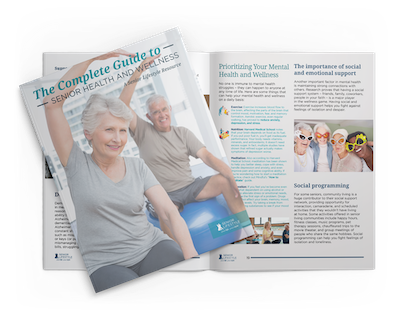While sitting may seem harmless, it can actually be very dangerous to your health if done to excess. In fact, sedentary living has been linked to many health problems, including obesity, diabetes, heart disease, and even dementia. Researchers call this “sitting disease.”
For many seniors, a sedentary lifestyle becomes more common due to mobility issues, chronic pain, and other health conditions.
Explore the dangers of a sedentary lifestyle for seniors, the warning signs, and some strategies to combat it.
What is ‘Sitting Disease’?
When we sit for long periods of time, our bodies are not engaging in the physical activity necessary to maintain good health. This can lead to a variety of health problems – more than 30 chronic diseases and conditions, according to the National Institutes of Health.
According to the NIH, people were intended to be bipedal. It says people moved much more throughout the day before the Industrial Revolution than they do now.
Some studies have even suggested that prolonged sitting can be just as harmful for your health as smoking cigarettes. It’s important to take regular breaks from sitting and engage in physical activity to prevent the negative consequences of sitting disease.
Dangers of Sedentary Living for Seniors
Sedentary people face a variety of dangerous consequences, including:
- Chronic disease: Less activity can lead to an increased risk of chronic conditions such as diabetes, heart disease, and stroke.
- Cognitive decline: A sedentary lifestyle has been linked to cognitive decline and an increased risk of dementia in seniors. Read more about cognitive decline and Alzheimier’s disease.
- Decreased mobility: Lack of physical activity can lead to decreased mobility and less independence, which can have a significant impact on the quality of life for seniors.
- Increased risk of falls: Weak muscles and poor balance resulting from a lack of physical activity can increase the risk of falls and fractures. Read more about falls and how to prevent them.
- Mental health problems: Seniors who are sedentary are at an increased risk of developing depression and anxiety. Read more about depression in seniors.
- Muscle degeneration: Prolonged inactivity can lead to muscle degeneration, making it harder for seniors to carry out daily activities.
- Obesity: Sitting burns fewer calories, which can lead to weight gain.
- Poor circulation: Lack of physical activity can lead to poor circulation, which can result in blood clots and other circulation-related problems.
How Inactivity Can Lead to Dementia
As mentioned earlier, a sedentary lifestyle has been linked to an increased risk of dementia. A study published in Translational Psychiatry found that older adults who spent more time sitting had a higher risk of developing dementia than those who were more physically active. Another study published in the British Journal of Sports Medicine found that physical activity can help delay the onset of dementia and slow its progression.
Some doctors think inactivity can lead to reduced blood flow to the brain, which can affect cognitive function. In addition to getting blood to flow to the brain, physical activity can stimulate the growth of new brain cells, which can help protect against age-related cognitive decline.
A sedentary lifestyle can also have social and psychological effects that can increase the risk of dementia. Social isolation and loneliness have been linked to an increased risk of dementia, and a sedentary lifestyle can contribute to these factors by reducing social interactions and decreasing overall quality of life.
>> Read “The Mental Health Benefits of Socializing for Seniors”
To reduce the risk of dementia, it’s important for older adults to engage in regular physical activity and to stay socially engaged. Even light physical activity such as walking or gardening can have significant health benefits and may help protect against cognitive decline. It’s also important to maintain a healthy diet and to manage other risk factors for dementia, such as high blood pressure and diabetes.
By taking these steps, you can reduce your risk of developing dementia and enjoy a higher quality of life in your later years.
Warning Signs of a Sedentary Lifestyle in Seniors
There are several warning signs that may indicate that you have a sedentary lifestyle:
- Bad posture: If you find that you slouch when you sit, it may be a sign that your muscles are weak from a lack of activity.
- Fatigue: If you feel tired or exhausted frequently, it may be due to a lack of physical activity.
- Joint pain: If you experience joint pain when you stand up after sitting for a while, it may be a sign that your muscles have become stiff from lack of movement.
- Limited mobility: If you have difficulty getting up from a chair or walking short distances, it may be a sign of limited physical activity.
- Poor balance: If you have trouble maintaining balance, it may be a sign of weak muscles resulting from a lack of physical activity.
- Weight gain: If you are gaining weight despite not eating more, it may be a sign of a sedentary lifestyle.
How Seniors Can Combat Sedentary Lifestyle
Fortunately, there are several strategies that can help you combat a sedentary lifestyle:
- Balance exercises: You can improve balance and reduce the risk of falls with balance exercises.
- Group exercise: Exercising in a group can not only benefit you physically but mentally as you socialize at the same time.
- Physical activity: Engaging in physical activity, even if it’s just a short walk, can help improve overall health and reduce the risk of chronic disease.
- Strength training: Strength training can help improve muscle strength and balance, reducing the risk of falls and fractures.
- Stretching exercises: Gentle stretching exercises can help improve flexibility and reduce muscle stiffness.

Download The Complete Guide to Health & Wellness for Seniors
As people grow older, their health and wellness needs change. Read our eBook, “The Complete Guide to Health & Wellness for Seniors” for everything you need to know about staying healthy and happy as we age.
Download the GuideStay Active at a Senior Lifestyle Community
A sedentary lifestyle can have severe consequences, including an increased risk of falls, chronic disease, decreased mobility, and cognitive decline.
You will find plenty of opportunities for physical activity and social interaction at a Senior Lifestyle community to maintain your independence and well-being. With exercise classes, social opportunities and group activities, you’ll find a fun, active, stimulating life as we take care of your everyday needs.
Find out more about Senior Lifestyle and schedule a tour.

